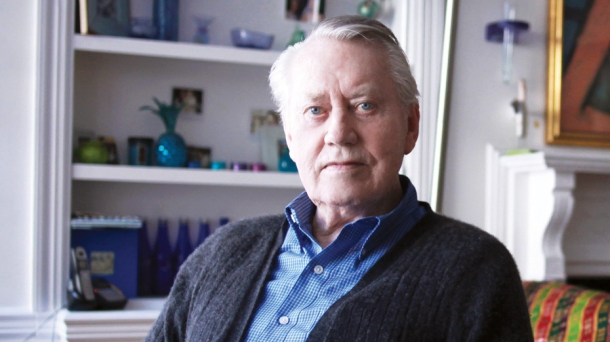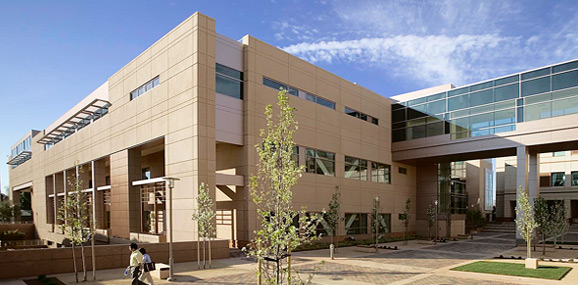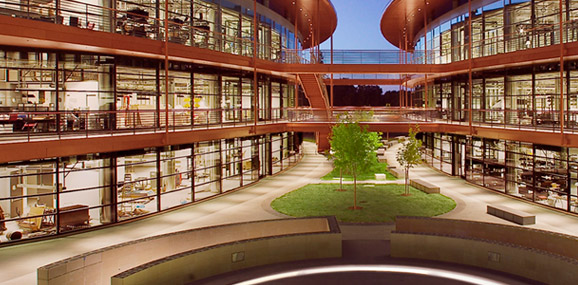The Quiet Change-Maker
Resource type: News
Stanford Benefactor | [ View Original Source (opens in new window) ]
Although Chuck Feeney has kept a low profile, his generosity has served as a catalyst for extraordinary scientific breakthroughs.

Chuck Feeney, one of Stanford’s most generous yet least-known supporters, is on track to give away more than $7.5 billion to causes worldwide. PHOTO: Pascal Perich
Chuck Feeney knows how to spot an opportunity—and he is willing to invest the resources to make change happen. Nearly 20 years ago, when scientific research was organized by clearly separated academic disciplines, he recognized the potential to accelerate discovery by bringing creative minds out of their silos. He also anticipated the essential role that state-of-the-art buildings would play in facilitating the flow of people and ideas.
Stanford was thinking in much the same way. Under the cover of strict anonymity, Feeney (then a newly minted Stanford parent) forged a relationship with university leaders and began exploring projects on the drawing board. Thanks to his behind-the-scenes generosity, key ideas soon became reality. Although you won’t find his name anywhere on campus, Chuck Feeney is behind some of Stanford’s most innovative facilities, from Campus Drive to the heart of the Medical Center.
“Chuck is a remarkable philanthropist—a true visionary who is willing to take a risk on potentially transformative ideas,” says Stanford President John Hennessy. “His gifts represented a bold investment in interdisciplinary collaboration before there was any proof-of-concept. Today, we see that paying off in spades. We are enormously grateful for his quiet partnership and incredible generosity.”

The Scully Center for Clinical Research at Stanford
Buildings That Changed Stanford
In 1996, Feeney agreed to help Stanford construct a new facility to advance translational medicine. The project would become part of a sea change in academic research. The Scully Center for Clinical Sciences Research, as the building is now known, placed scientists who make basic discoveries side by side with investigators who move those findings from the laboratory toward clinical applications that can benefit patients. Feeney’s investment, which totaled $50 million, has enabled collaborators to make significant progress in critical areas like lymphoma, skin cancer, and radiation therapy.
In 1998, he gave $25 million toward the new Stanford Cancer Center, to be constructed on Blake Wilbur Drive. The facility made the patient experience more coordinated, comprehensive, and scientifically advanced than ever before.
For example, one floor is devoted to cutting-edge radiation oncology, including two CyberKnives (a system invented at Stanford). Audiovisual technology allows doctors outside the Bay Area to consult with Stanford tumor boards. The building was pivotal in earning Stanford designation as a National Cancer Institute Cancer Center and a top-10 cancer care ranking in U.S. News & World Report.
It wasn’t long before another Stanford project captured Feeney’s attention. In 2000, he contributed $60 million toward the Clark Center for Biomedical Engineering and Sciences. The university’s boldest facility yet, it serves as the home of Stanford Bio-X, a hub for collaboration among researchers in medicine, engineering, computer science, physics, and the biological sciences.

The Stanford Cancer Center
Since the Clark Center opened in 2003, it has spawned a host of new research directions including optogenetics, a revolutionary tool that controls brain activity with pulses of light, now used by researchers worldwide. Other crucial work includes neural prosthetics controlled by patients’ thoughts, as well as microfluidics, or “labs on a chip,” that have revolutionized research in myriad fields.
Also located in the facility is Stanford’s Biodesign Program, which trains research fellows to turn discoveries into innovative, cost-effective medical technologies addressing the needs of patients around the world. Through on-the-ground centers in India and Singapore, and a new affiliate program in Ireland, the program has helped to build out local ecosystems for biomedical innovation and technology. Thirty-three companies and numerous patents have emerged in 14 years.
Thanks in part to Feeney’s support for these signature projects, Stanford quickly became a leader in cross-disciplinary, translational research. Numerous institutions seek to emulate the model established here.
Feeney made the gifts through his foundation, The Atlantic Philanthropies.
“Atlantic’s support for Stanford exemplifies Chuck’s belief that ‘good buildings for good minds can make a big difference,’ and that the great opportunity at Stanford is to apply those great minds toward innovation in health and science,” says Christopher G. Oechsli, president and CEO of Atlantic Philanthropies. “More than just bricks and mortar, the impact can be measured through the many cutting-edge discoveries made by faculty and students that lead to systemic improvements in the lives of millions.”

The Clark Center for Biomedical Engineering and Sciences at Stanford
Setting an Example
Chuck Feeney amassed a fortune as co-founder of the airport retail giant Duty Free Shoppers (DFS), a business he built from the bottom up in the aftermath of World War II. He also founded the global private equity firm General Atlantic in 1980 to ensure that wealth, and his ability to give back, would continue to grow. But he was known for drugstore wristwatches and economy travel—stealth, not wealth, and certainly not major philanthropy.
By the time Forbes magazine included him on its annual list of the world’s wealthiest people, Feeney had secretly transferred his interest in DFS and the vast majority of his wealth to The Atlantic Philanthropies. He stayed quietly in the background, shunning all forms of public recognition. Although he was giving away hundreds of millions, nobody knew.
Stanford is but one part of Feeney’s story. Through The Atlantic Philanthropies, he has plowed billions into research, health care, human rights, and education in Ireland, Australia, South Africa, Vietnam, Bermuda, and the United States. At age 83, he has established a tremendous philanthropic legacy and an impressive record of impact. By the time Atlantic Philanthropies closes its doors in 2016, it will have given away more than $7.5 billion over its 30-year life span.
Bill Gates and Warren Buffet cite Feeney as an inspiration for the Giving Pledge, which to date has encouraged more than 120 billionaires to commit to giving away at least half their wealth. In his own pledge, Feeney wrote, “the process of—and most importantly, the results from—granting this wealth to good causes has been a rich source of joy and satisfaction for me and for my family.”
Of late, Chuck Feeney has shed his anonymity to go public as a donor. After years of quiet giving, he sees yet another opportunity: to inspire others of similar means and to underscore the need to “cultivate change”—sooner rather than later. Indeed, the “giving while living” example that he has set and the lessons to be learned from his philanthropy may be Chuck Feeney’s greatest gift yet.
Chuck Feeney received a Forbes 400 Lifetime Achievement Award in June 2014. The honor was presented by Warren Buffett, with special remarks by Steven Denning, MBA ’78, General Atlantic chairman and chair of Stanford’s Board of Trustees.